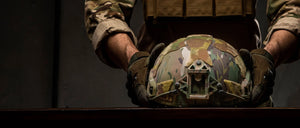Essential Maintenance and Care Tips for Your Ballistic Helmet
Ballistic helmets are a tool that should be taken care of in order to have the best performance over the longest period of time. Ballistic helmets are often exposed to varying temperatures and weather conditions which, over the course of its life, can deteriorate a ballistic helmet's effectiveness. Prolonged exposure to moisture, extreme temperatures, and direct sunlight are best avoided without adequate protection. After these encounters it's best to do a little bit of maintenance. We will go over that here.
Frequency and Methods of Cleaning
When you go for prolonged periods of time in heavy rain, snow, or excessive heat it's best to maintain it right after use. In milder conditions maintenance frequency is not as often. A simple cleaning every few months would suffice. This can be done with mild soap, soft sponges, soft bristle brushes, lukewarm water, and microfiber towels to dry. You want to avoid harsh chemicals, abrasive scrubbing tools, and hot water to prolong the finish of your helmet.
Cleaning the Helmet Shell
When cleaning the outer shell of your helmet you'll want to remove any cover’s and or accessories you have mounted. Once the helmet is bare, begin to scrub with lukewarm soapy water using a soft sponge or soft bristle brush. This is mainly to remove excess dirt and grim. It is optional whether or not you want to remove the side rails and shroud. Use your best judgment when deciding to do so or not based on the severity of buildup. We have seen that soft magic erasers work great for removing stubborn stains or residues.
Care for Interior Padding and Straps
With use you will most likely notice odor build up in the padding and suspension system of your helmet from sweat. The best way to clean these is first by removing them from your helmet. Most helmet padding is best cleaned by hand washing in lukewarm water with mild/natural detergents. You can use a soft bristle brush to lightly agitate stuck on dirt. Rinse thoroughly and wring out before letting air dry. The same process can be followed for your suspension system.
Proper Storage
Storage Environment
Storing your helmet at room temperature is ideal. We recommend using some sort of designated padded storage bag to keep and transport them in. These will protect your helmet and additional accessories from unnecessary exposure and damage. If you are planning to store it in a safe or similar place it's important to use some type of desiccant to avoid moisture inside. We also recommend removing batteries from accessories on your helmet when being stored for a prolonged amount of time to avoid any decay.
Avoiding Harmful Exposures
It is important to keep your helmet out of direct sunlight, extreme temperatures, and away from harsh chemicals. Unnecessary and prolonged exposure to these can adversely affect your helmet. When transporting it's best to use a padded helmet carrier bag of some sort. This will do an excellent job of preventing damage from accidental drops or impacts. Oftentimes your helmet accessories can be put inside of your helmet for added protection inside your carrier. Many also come with MOLLE attachments so you can attach your carrier to bags and such.
Regular Inspections
Be cognizant of wear and damage your helmet sustains during use whether training or in the field. This is a good thing to check after every use. Damaged padding, suspension, rails, and shrouds can often be replaced but when shells are heavily damaged it's usually time for a new helmet. Rails and shrouds should be inspected often as these secure your accessories to your helmet. Avoiding this could lead to accidental dismounting and damage to accessories because of damaged rails and shrouds. Be on the lookout for cracks, dents, and other degradation on the shell. After any type of penetration, stop use immediately to prevent injury or death as the shell is likely compromised.
Conclusion
The saying take care of your equipment and your equipment will take care of you still rings true even within ballistic helmets. Remember to clean your helmet inside and out regularly. After use and cleaning, store properly. Avoid unnecessary exposure and damage by storing and transporting properly with a designated helmet carrier. Do regular inspections to minimize accidental damage to your helmet accessories. Just like you, we hope you give your helmet the necessary protection to stay in the game for as long as possible.
